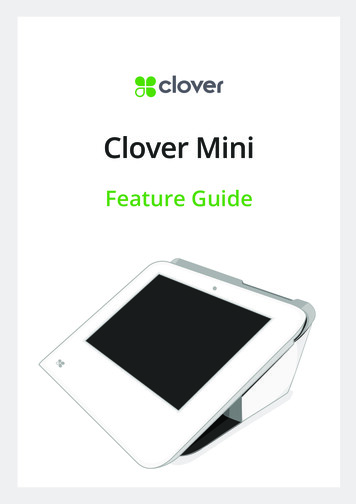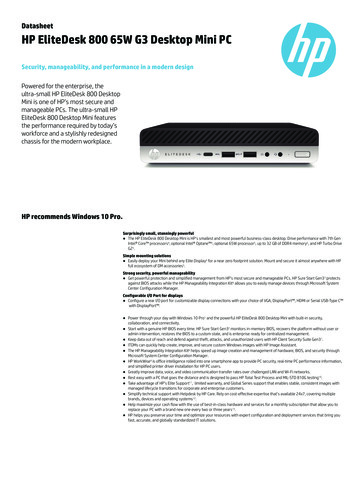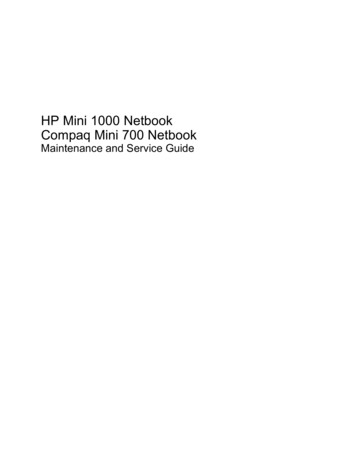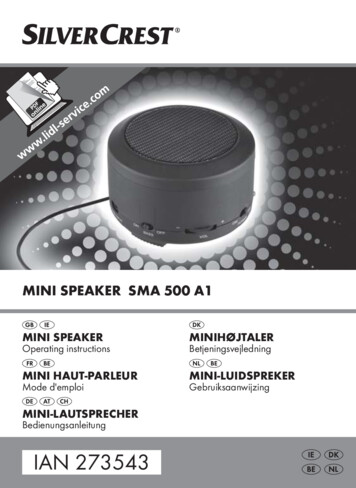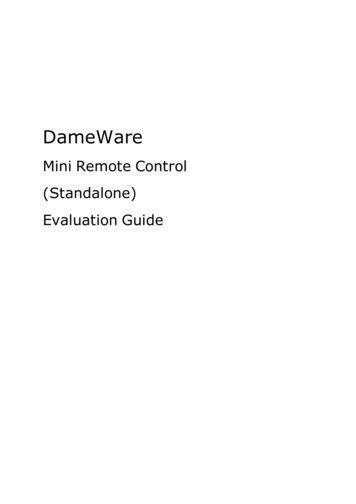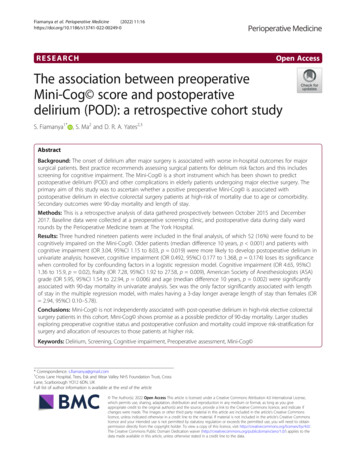
Transcription
Fiamanya et al. Perioperative Medicine(2022) EARCHOpen AccessThe association between preoperativeMini-Cog score and postoperativedelirium (POD): a retrospective cohort studyS. Fiamanya1* , S. Ma2 and D. R. A. Yates2,3AbstractBackground: The onset of delirium after major surgery is associated with worse in-hospital outcomes for majorsurgical patients. Best practice recommends assessing surgical patients for delirium risk factors and this includesscreening for cognitive impairment. The Mini-Cog is a short instrument which has been shown to predictpostoperative delirium (POD) and other complications in elderly patients undergoing major elective surgery. Theprimary aim of this study was to ascertain whether a positive preoperative Mini-Cog is associated withpostoperative delirium in elective colorectal surgery patients at high-risk of mortality due to age or comorbidity.Secondary outcomes were 90-day mortality and length of stay.Methods: This is a retrospective analysis of data gathered prospectively between October 2015 and December2017. Baseline data were collected at a preoperative screening clinic, and postoperative data during daily wardrounds by the Perioperative Medicine team at The York Hospital.Results: Three hundred nineteen patients were included in the final analysis, of which 52 (16%) were found to becognitively impaired on the Mini-Cog . Older patients (median difference 10 years, p 0.001) and patients withcognitive impairment (OR 3.04, 95%CI 1.15 to 8.03, p 0.019) were more likely to develop postoperative delirium inunivariate analysis; however, cognitive impairment (OR 0.492, 95%CI 0.177 to 1.368, p 0.174) loses its significancewhen controlled for by confounding factors in a logistic regression model. Cognitive impairment (OR 4.65, 95%CI1.36 to 15.9, p 0.02), frailty (OR 7.28, 95%CI 1.92 to 27.58, p 0.009), American Society of Anesthesiologists (ASA)grade (OR 5.95, 95%CI 1.54 to 22.94, p 0.006) and age (median difference 10 years, p 0.002) were significantlyassociated with 90-day mortality in univariate analysis. Sex was the only factor significantly associated with lengthof stay in the multiple regression model, with males having a 3-day longer average length of stay than females (OR 2.94, 95%CI 0.10–5.78).Conclusions: Mini-Cog is not independently associated with post-operative delirium in high-risk elective colorectalsurgery patients in this cohort. Mini-Cog shows promise as a possible predictor of 90-day mortality. Larger studiesexploring preoperative cognitive status and postoperative confusion and mortality could improve risk-stratification forsurgery and allocation of resources to those patients at higher risk.Keywords: Delirium, Screening, Cognitive impairment, Preoperative assessment, Mini-Cog * Correspondence: s.fiamanya@gmail.com1Cross Lane Hospital, Tees, Esk and Wear Valley NHS Foundation Trust, CrossLane, Scarborough YO12 6DN, UKFull list of author information is available at the end of the article The Author(s). 2022 Open Access This article is licensed under a Creative Commons Attribution 4.0 International License,which permits use, sharing, adaptation, distribution and reproduction in any medium or format, as long as you giveappropriate credit to the original author(s) and the source, provide a link to the Creative Commons licence, and indicate ifchanges were made. The images or other third party material in this article are included in the article's Creative Commonslicence, unless indicated otherwise in a credit line to the material. If material is not included in the article's Creative Commonslicence and your intended use is not permitted by statutory regulation or exceeds the permitted use, you will need to obtainpermission directly from the copyright holder. To view a copy of this licence, visit http://creativecommons.org/licenses/by/4.0/.The Creative Commons Public Domain Dedication waiver ) applies to thedata made available in this article, unless otherwise stated in a credit line to the data.
Fiamanya et al. Perioperative Medicine(2022) 11:16BackgroundDelirium can be defined as an acute decline in cognitivefunction and attention (American Geriatrics Society Expert Panel, 2015). It is reported to be the commonest surgical complication in older adults, affecting up to 50% ofolder surgical patients at an annual cost of 150 billion inthe USA alone (American Geriatrics Society Expert Panel,2015). Postoperative delirium (POD) in patients who haveundergone major elective surgery is associated with worsein-hospital outcomes that include longer length of stay,discharge to a higher level of care than that which was inplace at admission and increased mortality (Abelha et al.,2013; Chaiwat et al., 2019; Cunningham & Kim, 2018;Korc-Grodzicki et al., 2015; Raats et al., 2015; Robinsonet al., 2009b). Patients with POD have been shown to havean increased risk of mortality at 6-month follow-up(Abelha et al., 2013; Robinson et al., 2009b) as well ashigher rates of hospital readmission and a decrease inoverall function (American Geriatrics Society ExpertPanel, 2015; Crocker et al., 2016) than patients withoutPOD. This has led to the American Society of Anesthesiologists describing it as a public health concern and setting up the Brain Health Initiative (Perioperative BrainHealth Initiative [Internet], 2020). This project campaignsto improve awareness of the importance of cognitivescreening and the adoption of cognition protective measures in the perioperative period.Preoperative assessment reviews a patient’s physiologicalstatus in order to predict perioperative outcomes; aprocess complicated by the complexities of surgery in elderly patients with multiple comorbidities (Foo, 2013). Systematic reviews have identified cognitive impairment as apredictor of postoperative delirium in elderly patients(Dasgupta & Dumbrell, 2006; Oh et al., 2015; Raats et al.,2016; Yang et al., 2016), and it is recommended that preoperative assessment includes a measurement of patients’cognitive status (American Geriatrics Society ExpertPanel, 2015). However, a systematic review of predictionmodels for delirium in older adult inpatients found themto be inadequate (Lindroth et al., 2018).The Mini-Cog is a short instrument which has beenvalidated to screen for cognitive impairment in a broadrange of patients (Mini-Cog , 2018). It consists of athree-word recall test for memory, and a clock drawingtest of visuo-spatial and executive function. It is scoredout of five, and a score of less than three has been validated for dementia screening (Mini-Cog , 2018). It caneasily be integrated into preoperative assessment workflows (Culley et al., 2016) in 2.5 min or less (Long et al.,2012). In addition Mini-Cog appears to predict POD inelderly patients undergoing elective surgery (Culley et al.,2017; Dworkin et al., 2016; Robinson et al., 2012), with theproportion of patients developing delirium increasing byas much as nine times in those with low versus highPage 2 of 7scores (Dworkin et al., 2016). Preoperative Mini-Cog score has been shown to have a negative predictive value(NPV) for delirium of up to 94%, indicating its potentialas a screening tool to identify those at low risk of postoperative delirium (Dworkin et al., 2016). Mini-Cog hasalso been shown to be associated with postoperative complications other than delirium in older surgical patients,including odds of being discharged to a place other thanhome, risk of longer hospital length of stay (Culley et al.,2017) and 6-month mortality (Robinson et al., 2009a;Robinson et al., 2012). Most studies have primarily investigated the relationship between Mini-Cog and POD usingunivariate (Dworkin et al., 2016; Robinson et al., 2012) orage-adjusted analysis (Culley et al., 2017). When morecomprehensive, multivariate analyses have been used,links between Mini-Cog and POD have been variable,with some studies showing a continued effect (Dworkinet al., 2016; Robinson et al., 2009b), and others not(Robinson et al., 2012).MethodsAimThe aim of this observational study was to identify therelationship between preoperative Mini-Cog scores andPOD in patients undergoing elective colorectal surgerywhen controlling for other physiological and demographic variables that could possibly influence the incidence of POD. Secondary outcome measures were therelationship between Mini-Cog scores and 90-day mortality and length of stay.Data collectionThis is a retrospective analysis of prospectively collecteddata routinely gathered between October 2015 andDecember 2017 at The York Hospital. Data were analysed for patients older than 55 years (or over 50 years ifthey had significant comorbidities) undergoing majorelective colorectal surgery. This includes routine collection of perioperative risk factors and outcomes for localaudit and service development. As all data are collectedroutinely and anonymised, the York & ScarboroughTeaching Hospitals NHS Foundation Trust Researchand Development department viewed this project as ‘lowrisk research’ and as such no formal ethics committeereview was required. The Health Research Authorityconfirmed this and HRA approval was obtained (IRASProject ID 243694).Patients that did not undergo planned surgery or hadno Mini-Cog assessment were excluded. Preoperativevariables that were thought to be possible factors in influencing POD included ASA grade, Rockwood ClinicalFrailty Scale score (frailty score) and a determination ofanaerobic threshold (AT) via cardiopulmonary exercisetesting. Outcome data were collected prospectively by a
Fiamanya et al. Perioperative Medicine(2022) 11:16Perioperative Medicine Nurse Specialist (SM), and confusion was assessed during a daily clinical review. Delirium was defined by clinically significant new confusion,fluctuating attention, or impaired cognition. Outcomedata for 90-day mortality and hospital length of staywere collected after patient discharge from the Trust’selectronic database.Statistical analysisA previous study by Colley et al. demonstrated incidencesof POD in a cohort of elderly orthopaedic patients, of 21%in those with poor MiniCog scores ( 3) versus 7% inthose who scored 3 (Culley et al., 2017). To investigate asimilar level of preoperative cognitive impairment andPOD in our surgical cohort would require 300 patients(assuming α 0.05 and a power of 0.9). This sample sizewould also allow exploratory analysis of other variablesthat may influence POD in multivariate analysis.All data were anonymised and held on a secure MS Access database, then exported via Microsoft Excel to SPSSversion 19.0 for analysis. A Mini-Cog score 3 was usedas the cut-off for cognitive impairment. Variables were selected based on their clinical significance. ASA grade wasdichotomised into low ( 3) and high ( 3) and frailtyscore was dichotomised into not-frail ( 4) and frail ( 4)in order to ensure significant events for robust analysisdue to highly skewed distributions, and to enable a clinically relevant interpretation. Baseline characteristics of preoperatively low scoring Mini-Cog vs normal scoringMini-Cog patients were first tested for distribution, thencompared using Mann-Whitney U tests for nonparametric continuous data and chi-squared tests for categorical data. Associations between Mini-Cog score andPOD were investigated by univariate analysis using MannWhitney U or Fisher’s exact tests for continuous data andchi-squared tests for categorical data. For variables associated with the outcome and Mini-Cog score at an alphalevel 0.1, binary logistic regression was used to determine if Mini-Cog score was independently associatedwith POD. Associations between Mini-Cog score and90-day mortality were investigated by univariate analysisusing Mann-Whitney U or Fisher’s exact tests for continuous data and chi-squared tests for categorical data. Associations between Mini-Cog score and length of stay wereinvestigated by multiple linear regression analysis. Associations were deemed significant at p 0.05.ResultsBaseline characteristicsData were collected for 357 perioperative patients, with319 included in the final analysis and 36 excluded due toincomplete data or not meeting inclusion criteria. Fiftytwo (16%) were found to be cognitively impaired. Patientswith cognitive impairment were older than unimpairedPage 3 of 7patients (75 years [IQR 11] vs 70 years [IQR 13], p 0.001). They were also twice as likely to have an ASAgrade 3 (OR 2.14, 95%CI 1.17 to 3.91, p 0.012). Frailtywas recoded into a dichotomous variable. Only two patients (0.6%) were recorded as having a formal dementiadiagnosis. This likely reflects underdiagnosis rather thanthe true prevalence and consequently dementia was excluded as an independent variable. Baseline characteristicsare shown in Table 1.Postoperative deliriumOverall incidence of POD was 6.3%. Mini-Cog had asensitivity of 35% and 85% specificity for predicting subsequent POD. Negative predictive value was 95%. Univariateand logistic regression analysis are shown in Table 2. Onlyage (OR 0.492, 95%CI 0.177 to 1.368, p 0.174) remainsan independent risk factor for the development of PODwhen controlling for other preoperative variables usingbinary logistic regression.90-day mortalityMiniCog score, frailty, ASA grade and age were associated with 90-day mortality in univariate analysis (OR4.65, 95%CI 1.36 to 15.9, p 0.02) (Table 3). There wereinsufficient outcomes to perform logistic regression withother independent variables.Length of stayThe model to predict length of stay based on age, frailty,sex, cognitive impairment, anaerobic threshold, type ofsurgery (open vs closed vs converted) and ASA grade wassignificant using ANOVA at p 0.040 (F 2.054, df 8).R2 0.029. In the full multiple regression model, sexremained the only factor significantly associated withlength of stay, with males having a 3-day longer averagelength of stay than females (OR 2.94, 95%CI 0.10 to5.78, p 0.04) (Table 3). There was a high degree of skewin the normality plot of standardised residuals, and uniform variance of standardised residuals was not demonstrated. Durbin-Watson statistic was 0.794 indicatingsome correlation between independent variables. Tolerance statistics were above 0.2 and VIF statistics less than 2for all variables indicating there was no multicollinearity.DiscussionFrom the results of our analyses, Mini-Cog is not independently associated with POD or length of stay in patients undergoing elective major colorectal surgery.Whilst the Mini-Cog is associated with POD on univariate analysis, this association is lost when other variables which are also plausibly involved in the mediationof POD are added into the logistic regression model.This is important as it highlights the likely multifactorialnature of how POD arises and the necessity to provide a
Fiamanya et al. Perioperative Medicine(2022) 11:16Page 4 of 7Table 1 Baseline characteristicsMini-Cog ScoreLowNormalParticipants52 (16%)267 (84%)Age (years) median (IQR)75 (11)70 (13)p 0.001*Frailty score median (IQR)2 (1)2 (1)p 0.069*11.0 (4)11.9 (4)p 0.153*p 0.36**Anaerobic threshold (ml/kg/min) (median (IQR)Sex n (%)Female29 (56%)107 (40%)Male23 (44%)160 (60%)ASA grade 3 327 (52%)185 (70%)25 (48%)80 (30%)p 0.012**Surgery n (%)Colonic31 (60%)148 (55%)Rectal21 (40%)116 (43%)Mixed/other0 (0%)3 (1%)ASA American Society of Anesthesiologists grade, IQR interquartile range*Mann-Whitney U**Chi-squared testcomprehensive, holistic preassessment of the high-riskpatient.The Mini-Cog was also associated with 90-day mortality in univariate analysis, although we were unable toexplore this association with multiple regression due tolow mortality rates. Our results are both in keeping with,and build upon, previous literature by highlighting thedifficulty in predicting in-hospital delirium (Lindrothet al., 2018) and demonstrating that the link betweenpreoperative cognition and POD may be mediatedthrough other physiological variables (Culley et al., 2017;Dworkin et al., 2016; Robinson et al., 2012). Analysisshowed that at baseline, patients with poor Mini-Cog scores were on average 10 years older (p 0.001) andhad a higher ASA grade (p 0.012), which may reflect alink between multimorbidity and cognitive functionwhich is controlled for in multivariate analysis.In our sample, 16% of patients were found to havecognitive impairment as assessed by a Mini-Cog score 3, and 6.3% of patients were confused postoperatively.This is at the low end for incidence of POD found insystematic reviews, which ranges from 5 to 52% (Dasgupta & Dumbrell, 2006; Raats et al., 2016; Yang et al.,2016). However, most of these studies have involvedorthopaedic (mostly hip-fracture) and major vascularsurgery patients. Due to the emergent and traumatic nature of clinical presentation, they would likely havehigher levels of haemodynamic and general physiologicalinstability, with poorer perioperative optimisation thanthe elective patients in our sample, which may explainthe higher rates of POD.We chose a Mini-Cog cut-off of 3, which is validated for dementia screening. For broader preoperativeconfusion assessment that does not reflect cognitive impairment reaching the requirements for dementia, amore generous cut-off of 4 has been used, with relationships still found between Mini-Cog score andPOD, length of stay and even mortality (Robinson et al.,2009a; Robinson et al., 2012). Dworkin et al. showed thatraising the threshold from a score 3 to a score 5 onlyslightly increased NPV from 90 to 94%, indicating minimal benefit to a higher Mini-Cog score in the diagnosis of preoperative cognitive stability (Dworkin et al.,2016). Indeed, our NPV was 95%, further justifying ourchoice of 3 as the cut-off value. Our more stringent cutoff is appropriate for investigating the further role ofMini-Cog in identifying the risk of subsequent POD.Only two of our patients had a formal dementia diagnosis. This likely reflects underdiagnosis in our surgicalpopulation and is in keeping with a previous study thatalso identified no dementia diagnoses in their elderly patients (Dworkin et al., 2016). Screening for dementia viaMini-Cog , and using the cut-off of 3 to do so, maystill be an important tool for realising long term benefitsin terms of patient cognition and surgical outcomes.Possible dementia identified at a comprehensive preoperative assessment could be passed on to family doctors or specialist memory clinics either preoperatively orpostoperatively, to identify those with true dementia andensure long-term optimisation of patients.Mini-Cog score was associated with 90-day mortalityin the unadjusted analysis (OR 4.65, 95%CI 1.36 to 15.9,
Fiamanya et al. Perioperative Medicine(2022) 11:16Page 5 of 7Table 2 Postoperative deliriumNumberDeliriumNo delirium20 (6.3%)299 (93.7%)UnadjustedMedian (IQR)Age81 (9)Anaerobic threshold11.2 (2)Median difference71 (14)1011.9 (4)0.7n (%)AdjustedpOR (95% CI)p† 0.001*1.13 (1.06 to 1.22)0.0010.82 (0.31 to 2.14)0.690.49 (0.18 to 1.37)0.170.299*OR (95% CI)pSexFemale11 (55%)125 (42%)Male9 (45%)174 (58%)1.7 (0.69 to 4.22)0.25**2.13 (0.86 to 5.28)0.098**2.18 (0.59 to 8.07)0.209***3.04 (1.15 to 8.03)0.019**ASA grade 310 (50%)202 (68%) 310 (50%)95 (32%)Frail3 (18%)26 (9%)Not frail14 (82%)264 (91%)FrailtyMini-Cog scoreLow7 (35%)45 (15%)Normal13 (65%)254 (85%)Laparoscopy3 (15%)95 (32%)Open16 (80%)193 (65%)Converted1 (5%) 11 (4%)Type of surgery0.29**CI confidence interval, IQR interquartile range, OR odds ratio. Bold p 0.1, bold italics p 0.05*Mann-Whitney U**Chi-squared test***Fisher’s exact test Expected cell count 0.75†Logistic regressionTable 3 Multiple linear regression for Mini-Cog score andlength of stayOR95% CILowerUpperpConstant0.51 12.7113.730.94Sex2.940.105.770.04Age0.15 0.010.310.07Frailty1.11 4.146.370.68Mini-Cog score 3.16 6.990.660.11Open2.11 0.815.040.16Converted 1.39 8.976.190.72ASA grade0.84 2.344.020.60Anaerobic threshold 0.34 0.840.160.18SurgeryCI confidence intervalp 0.02). This finding is in keeping with previous evidence identifying a role for Mini-Cog in postoperativemortality in high-risk surgical patients (Robinson et al.,2009a; Robinson et al., 2012). This could be due to poorcognition reflecting a lack in other physiological reserve,or maybe due to confused patients being more at risk ofother morbidities such as falls. It is possible that poorcognition could affect patients’ ability to engage in postoperative rehabilitation techniques which act to minimise risk of developing chest infections and ileus, whilstensuring safe mobilisation. It is unsurprising that theother physiological variables (frailty, ASA grade and age)were also associated with this, but it is not clear if MiniCog score acts independently in this regard as our datadid not allow us to perform a multivariate logisticregression.Delirium is thought to be preventable in up to 40% ofpatients (American Geriatrics Society Expert Panel,2015). Identification of at-risk patients would allow clinical teams to institute measures to ameliorate the effectof anaesthesia and surgery on cognition. Screening with
Fiamanya et al. Perioperative Medicine(2022) 11:16Mini-Cog is very quick and cheap, and whilst we havedemonstrated that it does not act independently of othervariables, its use could increase the awareness of clinicalteams to the likelihood of patients developing POD. Increased awareness could then lead to early diagnosis viatargeted screening for cognitive change using a validatedscreening tool such as the Confusion AssessmentMethod (CAM). Intraoperative measures to reduce theincidence of POD may include the use of processed electroencephalographic (e.g. bispectral index) monitoringby anaesthetists, as a lighter depth of anaesthesia hasbeen shown to reduce rates of POD. Pharmacologicalmanagement could be targeted, for example by preferentially using regional blocks in high-risk patients to minimise the use of opioid painkillers, polypharmacy andpain-induced delirium. Non-pharmacological approachessuch as mobility enhancement, cognitive orientation,sleep enhancement measures and targeted nutrition andfluid therapy have also been demonstrated to be effective(American Geriatrics Society Expert Panel, 2015).LimitationsOur cohort contained very few patients with a formaldiagnosis of dementia and this prevented us from including this important and relevant diagnosis as a variable in our analysis. It is possible that this reflectsincomplete coding of the patient group rather than verylow rates of dementia. The study may also be underpowered given the low incidence of POD in our samplecompared to other studies.It is clear from our analysis that the association between the Mini-Cog score and POD is influenced byother factors. We collected data on some of those factorsbut there will be other variables (surgical magnitude,duration of anaesthesia/surgery, blood loss, etc.) at playwithin our specific cohort of colorectal patients whichwe did not record and analyse. This does limit the external validity and therefore generalisability of our analysis.Further exploratory work investigating other perioperative factors in wider surgical groups is warranted.A further limitation is the accurate capture of the outcome of POD in patients. This is judged clinically duringpostoperative ward rounds and is subject to possible interrater variability, particularly in missing cases of hypoactivedelirium. In a study comparing relationships betweenMini-Cog using delirium assessed using the CAM withdelirium assessed by review of clinical notes, age-adjustedOR remained of similar magnitude and statistical significance (CAM OR 4.52, 95%CI 1.3 to 15.68 p 0.017 vs.notes OR 3.41, 95%CI 1.26 to 9.23, p 0.016). It is therefore possible this may have affected our analysis; however,it is unlikely this would be significant enough to alter theinterpretation. Nevertheless, future studies could bePage 6 of 7improved by formally screening for delirium in daily wardrounds using a tool such as the CAM.Conclusion and recommendationsMini-Cog is not independently associated with POD inhigh-risk colorectal surgery patients. It is associated with90-day mortality in univariate analysis. Further exploration is warranted to confirm its role in relation to otherphysiological variables. These relationships should be investigated in further retrospective or prospective analyses using a larger sample sizes, and in studiesinvestigating the causes of mortality specifically in postoperatively confused patients. Importantly, this studybuilds on the body of literature that argues a holistic assessment of presurgical morbidity which includes brainend-organ dysfunction is essential, and provides evidence that pre-existing physiological criteria may be better suited to calculate this.AbbreviationsANOVA: Analysis of variance; ASA: American Association of Anesthesiologists;AT: Anaerobic threshold; BIS: Bispectral Index ; CI: Confidence interval;CAM: Confusion Assessment Method; CAM-ICU: Confusion AssessmentMethod for the Intensive Care Unit; df: Degrees of freedom; IQR: Interquartilerange; OR: Odds ratio; NPV: Negative predictive value; POD: Postoperativedelirium; VIF: Variance inflation factorAcknowledgementsDr. Simon Davies and Dr Jonathan Wilson, Consultant Anaesthetists whowere involved in the conception of the York Teaching Hospitals NHSFoundation Trust perioperative pathways. We also acknowledge Dr. Daviesfor his helpful comments on a late manuscript draft, Mrs. Zoe Murphy,Perioperative Medicine Nurse Specialist for her assistance in data collection,and the Health Foundation who financially supported the set up andrunning of the new perioperative programme in 2015 through an innovationgrant.Authors’ contributionsSM and DY conceived and designed the study and took part in datacollection. SM contributed to data input and cleaning. SF wrote the protocoland application for ethics approval. Data analysis manuscript write-up wasperformed by SF. All authors read and approved the final manuscript.FundingNo funding was provided for this study.Availability of data and materialsThe datasets used during the current study are available from thecorresponding author on reasonable request.DeclarationsEthics approval and consent to participateSponsorship was granted by the York & Scarborough Teaching HospitalsNHS Foundation Trust. Formal ethics committee review was deemedunnecessary as the project consisted of the analysis of routinely collected,anonymised data. HRA approval was obtained (IRAS Project ID 243694). MiniCog used for research purposes with permission.Consent for publicationN/ACompeting interestsThe authors declare that they have no competing interests.
Fiamanya et al. Perioperative Medicine(2022) 11:16Author details1Cross Lane Hospital, Tees, Esk and Wear Valley NHS Foundation Trust, CrossLane, Scarborough YO12 6DN, UK. 2York Hospital, York Teaching HospitalsNHS Foundation Trust, Wiggington Road, York YO31 8HE, UK. 3AcademicAlliance of Perioperative Medicine, Hull York Medical School, Heslington, UK.Received: 9 June 2020 Accepted: 14 January 2022ReferencesAbelha FJ, Luís C, Veiga D, Parente D, Fernandes V, Santos P, et al. Outcome andquality of life in patients with postoperative delirium during an ICU stayfollowing major surgery. Crit Care [Internet]. 2013;17(5):R257–7 Availablefrom: https://pubmed.ncbi.nlm.nih.gov/24168808.American Geriatrics Society Expert Panel. Postoperative delirium in older adults:Best practice statement from the American geriatrics society. J Am Coll Surg.2015;220(2):136–148.e1.Chaiwat O, Chanidnuan M, Pancharoen W, Vijitmala K, Danpornprasert P,Toadithep P, et al. Postoperative delirium in critically ill surgical patients:incidence, risk factors, and predictive scores. BMC Anesthesiol [Internet].2019;19(1):39 Available from: https://pubmed.ncbi.nlm.nih.gov/30894129.Crocker E, Beggs T, Hassan A, Denault A, Lamarche Y, Bagshaw S, et al. Longterm effects of postoperative delirium in patients undergoing cardiacoperation: a systematic review. Ann Thorac Surg [Internet]. 2016;102(4):1391–9. Available from:. ulley DJ, Flaherty D, Fahey MC, Rudolph JL, Javedan H, Huang C-C, et al. Poorperformance on a preoperative cognitive screening test predictspostoperative complications in older orthopedic surgical patients.Anesthesiology [Internet]. 2017;127(5):765–74 Available from: https://pubmed.ncbi.nlm.nih.gov/28891828.Culley DJ, Flaherty D, Reddy S, Fahey MC, Rudolph J, Huang CC, et al.Preoperative cognitive stratification of older elective surgical patients: across-sectional study. Anesth Analg [Internet]. 2016;123(1):186–92 Availablefrom: m J, Kim LD. Post-operative delirium: a review of diagnosis andtreatment strategies. J Xiangya Med [Internet]. 2018;3:8 Available upta M, Dumbrell AC. Preoperative risk assessment for delirium afternoncardiac surgery: a systematic review. J Am Geriatr Soc [Internet]. 2006;54(10):1578–89. Available from:. workin A, Lee DSH, An AR, Goodlin SJ. A simple tool to predict development ofdelirium after elective surgery. J Am Geriatr Soc [Internet]. 2016;64(11):e149–53. Available from:. https://doi.org/10.1111/jgs.14428.Foo I. Assessment of the elderly patient. In: The Annual Preoperative AssociationConference [Internet]. The Preoperative Association; 2013. Available t-elderly-patientKorc-Grodzicki B, Sun SW, Zhou Q, Iasonos A, Lu B, Root JC, et al. Geriatric assessment as apredictor of delirium and other outcomes in elderly patients with cancer. Ann Surg[Internet]. 2015;261(6
parametric continuous data and chi-squared tests for cat-egorical data. Associations between Mini-Cog score and POD were investigated by univariate analysis using Mann-Whitney U or Fisher's exact tests for continuous data and chi-squared tests for categorical data. For variables associ-ated with the outcome and Mini-Cog score at an alpha


